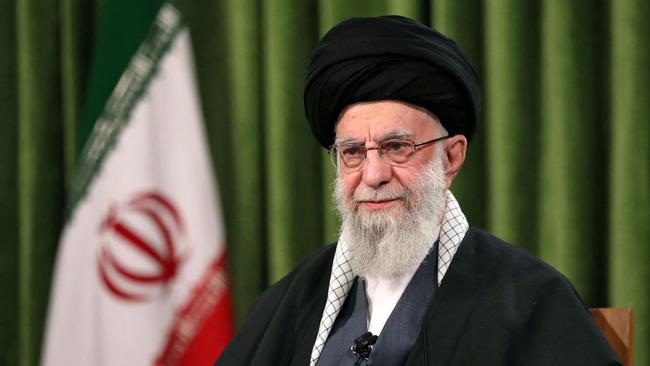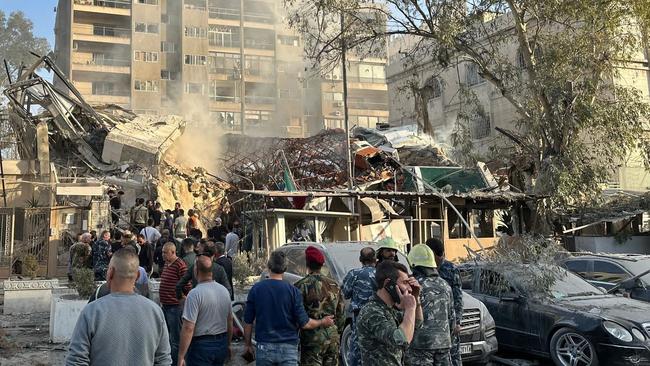Iran’s nuclear calculus has now become more dangerous
Supreme Leader Khamenei must wonder if Iran should have already tested a nuclear weapon. The West shouldn’t underestimate the ailing ayatollah’s need for a glorious legacy.

The rising tensions between Iran and Israel have provoked understandable foreboding. On April 1, an Israeli air strike killed a senior Iranian commander in Damascus. Last weekend, Iran responded by launching more than 300 drones and missiles at Israel, which in turn prompted Israel to strike targets in the Iranian city of Isfahan on Thursday night. As the two historic antagonists climb the tiger’s back, the Biden administration is hardly alone in fearing a regional conflagration.
The Islamic Republic seeks revenge for its dead, while Israel needs to restore deterrence, badly damaged by Hamas’s October 7 assault. If Israel fails to re-establish sufficient deterrence, it must prepare for a future filled with air-raid warnings and Israelis continuously in bomb shelters.
Lurking behind these anxieties is the Islamic Republic’s nuclear calculations. When the mullahs launched their atomic-weapon and ballistic-missile programs four decades ago, they were primarily thinking about countering Saddam Hussein’s Iraq, secondarily about checking the US. In those early days, as far as we can gather from Iranian sources about the genesis of the theocracy’s nuclear ambitions, a hatred of Israel and the regime’s fierce antisemitism weren’t significant drivers. That has surely changed.
Iran’s theocratic regime has to stand as the most successful imperial power in the Middle East since the British Empire. The comparison would offend the mullahs, but both managed to patrol large swathes of territory by relying on proxies – imperialism on the cheap. Soon after coming to power in 1979, Iran began putting together its collection of terrorists and militants. In Lebanon, it created Hezbollah, established a tight relationship with the Palestine Liberation Organisation (especially its lead military organisation, Fatah) and later funded the more explicitly Islamic Palestinian rejectionist groups Hamas and Palestinian Islamic Jihad.

The clerical elite learned early that they could inflict pain on their adversaries with a measure of impunity if they hid behind their proxies. Their record of achievement is extraordinary. Hezbollah’s bombing of the U.S. Marine barracks in Beirut in 1983 provoked America’s withdrawal from Lebanon, clearly showing that even a Western superpower could be deterred through terrorism. Shiite Islamists started the cult of suicide bombing, which has since become the calling card of Sunni holy warriors.
Then came the 9/11 wars, the Arab Spring of 2011-12, the Syrian civil war and, most recently, the return of the Taliban in Afghanistan, after the ignominious withdrawal of U.S. forces.
Civil wars and ethnic and sectarian conflicts have marked the new order, providing Iran with a bonanza of opportunities. The famed Islamic Revolutionary Guard commander Qassem Soleimani masterminded a multinational auxiliary force that could be deployed to various fronts. He created the so-called “axis of resistance,” Iran’s primary means for waging war against the Jewish state and America’s presence in Syria and Iraq. The Islamic Republic’s Shiite proxies lacerated US forces in Mesopotamia, helping to humble a superpower. Iran helped to fuel the “forever wars” that have up-ended and demoralised American foreign policy.
Once civil war broke out in Syria, Tehran marshaled approximately 80,000 militiamen from across the region to rescue the Assad dynasty. In 2015, Russian special forces and air power also arrived. Together they slaughtered their way to victory. Ever since, Israel has been waging an unending air campaign in Syria to stop Tehran from turning the country into another missile platform. In Yemen, the Houthis – wayward Shiites who were historically unloved by Iran’s branch of Shiism – proved eager surrogates of Tehran. They defeated the combined forces of the United Arab Emirates, Saudi Arabia and their Yemeni allies, humbling the impetuous Saudi crown prince, Muhammed bin Salman.

Through all of this mischief, Iran’s territory remained immune from retaliation as its embattled adversaries kept insisting that they could not expand the conflict.
Iran’s clerical regime celebrated Hamas’s Oct. 7 attack on Israel as a triumph of their “axis of resistance” strategy. Supreme Leader Ayatollah Ali Khameini intoned, “The cores of resistance are determining the fate of our region, and an example of them is the Al Aqsa Flood Operation.” Whether or not Khamenei gave the green light for the attack, his regime’s extensive military aid to Hamas was explicitly aimed to allow it to wage a more effective war against their mutual enemy.
Khamenei surely anticipated severe Israeli retaliation, while also assuming that the old rules would prevail: Iran would stoke its “rings of fire,” inflaming Israel’s frontiers through its proxies, and the ever-anxious West, led by the escalation-dreading Biden administration, would step in and impose a settlement on Israel. A badly battered Hamas would eventually emerge from its tunnels and declare victory.
To a large extent, the script has played out as Iran anticipated. Forced into unforgiving urban warfare, Israel has scorched Gaza. Facing increasing pressure from the White House, the IDF hasn’t moved on the last Hamas redoubt in Rafah. Unwilling or unable to sustain a significant occupation elsewhere in Gaza, Israeli forces are already encountering insurgent attacks in cleared areas.
Outside of Gaza, the Islamic Republic did what it needed to do. Hezbollah shot some of its rockets at Israel’s north, and the Houthis disrupted maritime traffic in the Persian Gulf. Tehran has been sending weapons to the West Bank. When Iran’s Shiite protégés in Iraq killed three American servicemen in Jordan, the Biden administration spared Iran and bombed its agents. At the UN, Tehran got the desired denunciations of Israel. South Africa, stuck in decline with nasty internal politics, has become a poster child for Third World grievances, with a special animus against the Jewish state. It charged Israel with genocide at the International Court of Justice.
Although Israel may be getting bogged down in Gaza and is in an increasingly severe wrestling match with the Biden administration on how to fight Hamas, Benjamin Netanyahu’s government has obviously decided to make Iran pay a higher price for its machinations. It did so loudly when it killed General Mohammad Reza Zahedi and six of his deputies in Damascus on April 1.
In life and death, Zahedi did not enjoy the public acclaim of Soleimani. The regime’s propaganda machine never touted his efforts to defeat Shiite-loathing Sunni extremists, which helped to make Soleimani a semi-sacred figure even among Iranians who despise the clerical regime. Zahedi was, however, a critical commander in Iran’s terror network, close to Hezbollah leader Hassan Nasrallah. He was also a significant player in Iran’s longstanding support of Hamas. Khamenei was well aware of Zahedi’s many accomplishments, which also included a significant stint in crushing Iran’s internal opposition, and would want to avenge him.

Still, the scale of Iran’s retaliation surprised many. The Iran-Israel duel had been a confrontation with understood limits: Iran relied on terrorism and Israel on cyberattacks and targeted assassinations. The Syrian civil war stretched those limits but didn’t erase them. The Islamic Republic built armed encampments on Israel’s borders; Israeli planes continuously pommeled them. Yet both sides exempted each other’s territory from direct assault. All that changed when Tehran shot hundreds of projectiles at Israel on April 14, followed by Israel’s retaliatory attack on targets in Iran on April 18. It is well-known that the ailing, 85-year-old Khamenei is trying to stage-manage his succession. This is not just succession at the very top; the country’s entire elite is changing. After years of purges, many conservative stalwarts of the revolution, such as former president Hassan Rouhani and former speaker of the parliament Ali Larijani, have been excised from the body politic. They are being replaced by more ideologically strident and parochial men drawn from the ranks of the Revolutionary Guard and conservative religious circles. All of these people are more bellicose toward both Israel and the US.
Israel has thus far limited its counter-attack to targets in the city of Isfahan, where Iran has nuclear facilities and an air base. It is unclear if this is the first salvo of a larger campaign or the sum total of its retaliation. Washington and the Europeans will certainly try to persuade Jerusalem to refrain from doing more. Netanyahu, whose bark has always been worse than his bite, has been allergic to war across his long career. Israelis in general seem divided between those who see their nation’s defence as coterminous with Washington’s wants and those more willing to risk American displeasure.
In anticipation of an Israeli military response, Brigadier General Ahmad Haghtalab, the commander for security of Iran’s nuclear facilities, suggested on Thursday how the Islamic Republic will use the nuclear shadow moving forward. “If the counterfeit Zionist regime would want to use the threat of attacking our country’s nuclear sites as a tool to put Iran under pressure,” he said, “revision of the Islamic Republic’s nuclear doctrine and polices as well as a departure from the previously announced reservations is conceivable and probable.”
Khamenei must wonder now if his situation would be better if Iran had already tested a nuclear weapon. Would Israel have attacked one of his cities if it had to think about the prospect of a mushroom cloud over Tel Aviv? As successful as the axis of resistance has been for Iran, it has not checked offensive Israeli actions. A combination of Islamist proxies and an Iranian bomb, however, might well do the trick.
Even after everything that has taken place lately in the region, the US intelligence community is at ease with its conclusion that “Iran uses its nuclear program to build negotiating leverage and respond to perceived international pressure.” Khamenei has not detonated a bomb because the program is a tool of diplomatic gamesmanship.
In reality, there are no technical barriers left that Iran’s engineers cannot overcome. Ali Akbar Salehi, the former head of the country’s Atomic Energy Organization and the regime’s most well-credentialed nuclear engineer, recently remarked: “We have [crossed] all the thresholds of nuclear science and technology.” Whatever the reasons behind Khamenei’s apparent reluctance to give the final green light, what’s happened since October 7 must certainly give him pause about this hesitation.

The Gaza war has clarified the struggle between Israel and Iran. The Palestinians, surely much to Hamas’s displeasure, are again bit players in the Middle East’s new great game. In such a contest of wills, nothing checks one side better than the fear that the other might actually use a nuclear weapon. The Islamic Republic obviously doesn’t fear Israel’s nuclear arsenal. The same can’t be said for the reverse. With the ultimate weapon behind it, Iran would be not just a nation of consequence but a regime too dangerous to fail for those Americans still dreaming of regime change. Nuclear weapons don’t change everything, but they change a lot.
In the past seven months, America and Israel have been shocked by two events that were once unthinkable: the attacks of Oct. 7, Israel’s mini-Holocaust, and Iran’s missile attack, the first direct assault on Israeli territory in 45 years of unrelenting enmity. The next surprise may well be an unexplained seismic tremor in one of Iran’s deserts. The elderly Khamenei could then look upon Ayatollah Ruhollah Khomeini’s massive mausoleum and say with all humility, “I have surpassed thee.”
Reuel Marc Gerecht, a former Iranian-targets officer at the Central Intelligence Agency, is a resident scholar at the Foundation for Defense of Democracies. Ray Takeyh is a senior fellow at the Council on Foreign Relations.
The Wall Street Journal




To join the conversation, please log in. Don't have an account? Register
Join the conversation, you are commenting as Logout